Nintendo has never introduced a true disaster to their core Legend of Zelda series, but most of the last ten years has felt lacking in inspiration. Games like Skyward Sword and Spirit Tracks were perfectly solid on their own merits, yet they paled in comparison to the more impactful entries from the series’ past. Attempts at freshening up the franchise usually came in the form of touch- or motion-based experiments, while the format of the games still riffed on established concepts dating as far back as the Super Nintendo. One major exception was 2013’s A Link Between Worlds (which was based on that same Super Nintendo game, ironically). With that 3DS installment, Nintendo finally made some bold changes to the series’ aging format. Tweaking the item system and allowing players to choose dungeon order proved to be a shot in the arm for a franchise that had long rested on its tried-and-true trademarks.
If A Link Between Worlds was the game that dared to change things up, Breath of the Wild is the game that blows everything wide open. It deems no rule sacred, removing or changing numerous systems we’ve come to expect from the franchise. The end result is a total reinvention of Zelda that manages to evoke the exact same feelings that made it iconic to begin with.
One of the most welcome changes is almost immediately apparent. While the past two console entries (Skyward Sword and Twilight Princess) had painfully long introductory sequences, this swings hard in the other direction. Link wakes up, briefly talks to a mysterious old man, and is exploring an open world and solving puzzles within minutes. It’s essentially the difference between “talk to everyone on this sky island for six hours” and “It’s dangerous to go alone! Take this.”
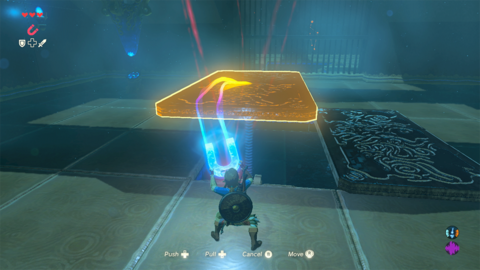
Your first order of business is to visit four mini-dungeons so that you can acquire four runes. These runes grant you the ability to create remote bombs, manipulate magnetic objects, stop time, and create pillars of ice in pools of water. Once you’ve proven that you know how to wield these powers, you’re given a paraglider that allows you to leave the opening plateau and experience the rest of Hyrule.
I was initially skeptical of this approach. In the past, a big part of the Zelda experience was obtaining new items within its dungeons. I was worried that by giving me powers upfront instead of doling them out in dungeons, the game would be taking away the joy of obtaining a new tool. In earlier games, you’d get something like the hookshot and realize that you could now cross that broken bridge or get on top of that plateau. Breath of the Wild replaces that joy with a much more substantial sense of freedom and possibility. You’re not waiting for an item in a treasure chest to let you get across that bridge or onto that plateau. You already have all the tools you need, it’s just a matter of making it happen.
With just these four abilities, you’re able to solve any of the game’s 100-plus shrines. You’re also able to explore almost all of the massive Hyrule map using just your paraglider and climbing ability. By giving you all of this upfront, Breath of the Wild is essentially saying “Here you go, have fun” and setting you loose. Upgrades to your stamina and gear certainly make climbing and traversal quicker and easier, but I was able to get just about anywhere I wanted with enough patience and planning.
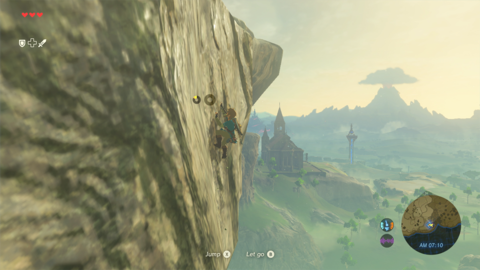
Plenty of open world games allow you to explore the entire map at your leisure, but Hyrule’s landscape and Link’s ability to climb makes for more rewarding exploration than I’ve ever seen in the genre. Most of the world isn’t accessible by easy-to-follow roads and waypoints. I spent many hours exploring off the beaten path, gliding across canyons, and scaling mountains. Some of these peaks seem insurmountable at first, but the summit can usually be reached if you’re smart about looking for places to rest and get a quick stamina recharge. When things go wrong, it often ends with Link ragdolling down the side of a rocky cliff. When they go right, there’s frequently a secret, a new vantage point for spotting shrines, or at least a beautiful view awaiting you.
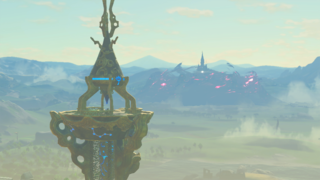
One thing you'll be climbing an awful lot of is towers. Each area of the map features one orange tower, and scaling it will turn it blue and fill in details for the region on your map. Unlike many open world games, filling it in doesn't mean it gives you the location of shrines, towns, and other points of interest. It simply gives you the outlines of major landmasses and bodies of water. Even small details like a hot spring won't be labelled until you're basically dipping Link's toes in it. Whenever you spot something that you think you might want to return to, it's easy to mark it on the map with a variety of icons. I found this to be extremely helpful for marking shrines that I spotted in the distance, areas that required arrows when I had none, mineral-rich mountainsides, and mysterious creatures and pieces of the environment that I wanted to investigate later.
It doesn’t feel like the map is huge for the sake of being huge. While there are stretches of unpopulated land, I never felt like I was at a loss for things to do. There are plenty of shrines to locate, wildlife to photograph and hunt, minerals and food to collect, friendly characters to help, and camps of enemies to battle and loot. One of my favorite things that happened frequently was finding myself out of my league. Since I spent so many of my early hours exploring the world, I’d inevitably wander into areas that I was not properly equipped for. Rather than running from these higher-level enemies, I saw them as a challenge. With no items being gated behind dungeons, I knew that the tools to beat these enemies were already at my disposal, even if any one of their attacks could wipe me out instantaneously. Taking out a Lynel late in the game feels like an accomplishment. Slaying one when I only had five heart containers felt like a triumph.
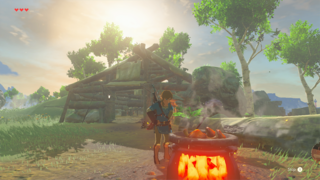
Your challenges won’t always come in the form of high-level enemies. My adventures off the beaten path sometimes came to an end when I found myself in the freezing cold without proper gear. Link would shiver and take damage until I had to teleport to safer ground and rethink my approach. Before you find new gear that helps you combat weather, you can fight the elements by cooking. It’s an imprecise and somewhat silly system, but it’s fun to experiment and toss a bunch of ingredients into a pot and hope for the best. You begin to learn the general formula for success after you screw up and create barely edible meals on enough occasions. If I knew I was heading into a cold region of the map, I’d gain some heat resistance by mixing spicy peppers into various meat and fruit dishes. If I was about to take on a difficult enemy, I’d make a few meals that utilized defense-boosting mushrooms and heart-restoring radishes.
I’m glad that the cooking system isn’t overly cumbersome, as it’s absolutely necessary. Among the sweeping changes to series tradition is the method in which you heal yourself. In almost every past entry, you could recover from a damaging battle by simply cutting some grass or breaking some pots until you found enough hearts. That option is nowhere to be found here. You can eat raw food off of the ground if you’d like, but you need to cook meals if you hope to have any serious source of health recovery.
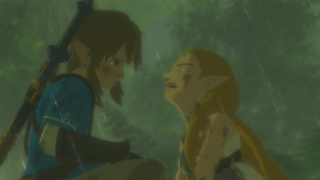
Not finding hearts in the wild is one of many seemingly minor changes that add up to make the game feel so much different than its predecessors. Rupees are rarely found in the field, as most are earned by selling materials and completing sidequests. Twilight Princess surprised me by requiring five heart pieces to make a container instead of four, but Breath of the Wild goes several steps further and omits them altogether (new hearts are earned by trading in orbs earned in shrines). You’ll be snatching fairies out of the air with your hand, as bottles are gone. Boomerangs will fly right back over your head if you don’t press A to catch them. Cutscenes feature voice acting. There’s a jump button.
Among the bigger changes is the optional nature and the structure of Breath of the Wild’s traditional dungeons. Like they’ve usually been, these are longer, puzzle-driven affairs that end in boss fights. That’s where the similarities end, however. The “get the map, the compass, the big key, and the dungeon item” format is completely gone. Those last three things are completely absent, and you’re given a map at the very beginning of each dungeon. How you interact with the dungeons themselves is a puzzle element unique to these areas, and I don’t want to spoil the specifics here.
These dungeons—like just about everything in the game—are completely optional. That said, they’re a lot of fun and will certainly make your final quest an easier ordeal. Perhaps more important than the traditional dungeons are the tiny shrines that are scattered across the map. These act as fast travel points, and you’ll be able to upgrade your heart or stamina capacity each time you complete four of them. Most of these are filled with traditional Zelda puzzles. You’ll utilize your runes and wits to place boxes onto switches, complete electrical circuits, manipulate balancing tools, and plenty more. On occasion, they’ll present you with tests of combat prowess or goofy motion-based mini-golf puzzles. If the process of getting to the shrine was particularly tough, sometimes it’ll simply present you with a treasure chest and send you on your way.
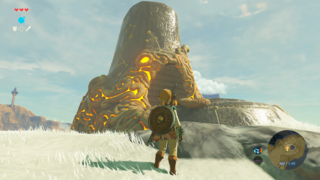
On the Switch, these shrines have the added benefit of being fantastic for portable play. This game can be a massive undertaking that benefits from long marathon sessions. On the other hand, these bite-sized shrines usually don’t take much time at all. If I’m on a bus and only have 20 minutes to play, I might not want to go on a lengthy quest into the wilderness. Knocking out a few shrines and upgrading my stamina is a perfectly reasonable task, however.
Most shrines feature hidden treasure chests. Frequently, these contain equipment like melee weapons, bows, or shields. I lost track of how many times I’d get to one, only to be told that my inventory was full. When this happened, I’d step away from the chest, cycle through what I was holding, and toss several items at my feet before grabbing my new toy. It’s frustrating at times, but you thankfully can upgrade your storage capacity by collecting hidden seeds and delivering them to a specific character.
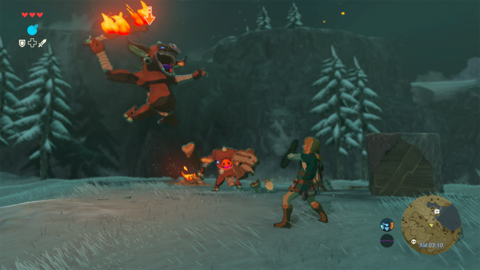
Another frustration comes about thanks to the weapons themselves. Almost all of them will break eventually, which can be annoying when you’re trying to decide what to bring into each battle. Do you want to use your awesome lightning sword on that group of basic Bokoblins, or do you want to dispatch them with your super-slow two-handed rusty broadsword? Some may enjoy the decision-making that this forces you to do, but I usually wished I could just go in swinging with my favorite weapon without worrying about it shattering. It can be a frustrating system at times, but it’s remedied somewhat by the steady availability of new weapons in the field.
Breath of the Wild also has issues on the technical end. Its art style and character design are among the best I’ve seen in the series, but there’s no denying that the framerate takes a big hit from time to time. This is most evident in areas like dense forests and populated towns. Things usually move along at a decent clip, but you’re bound to notice the game chugging if you take a stroll through Kakariko Village during a rainstorm. That said, I never felt like it interfered with combat or platforming scenarios at any point.
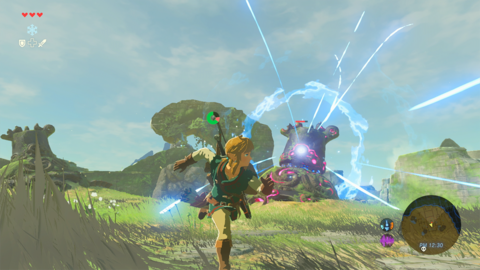
This can be either the shortest or—more likely—the longest Zelda game depending on how you play it. You can go for a novelty speed run and charge Ganon right out of the gate. You can put a couple of dozen hours into the adventure, beat two or three dungeons, and decide you’re ready to take on the endgame. Or you could do what I did, which is spend almost 100 hours exploring the map and enhancing Link’s gear, health, and stamina before you’re ready to see the credits.
You decide when it’s time to end the game. It’s a great feeling, and I loved having such a defined goal throughout (“Defeat Ganon” is the first quest given to you). I wanted to be as powerful as possible in preparation for the climactic battle. When the time came, I felt like I was in an action movie “gearing-up” montage as I purchased bundles of every type of arrow, optimized my weapon inventory, put on my highest-rated gear, and cooked plenty of hearty meals. With at least 30 well-salted meat dinners lining the pockets of my fanciest armor, I breached the perimeter of Hyrule Castle and prepared to take on Ganon.
There’s great joy to be found in the big moments like this as well as the myriad little details. I laughed when lightning struck me for the first time, instantly killing Link. I asked the goofy scientist guy in Akkala to introduce himself every time I saw him, because I couldn’t get enough of the little dance and sound effect that accompanied it. I was fascinated with what I found on Eventide Island, and spent over an hour making sure that I performed its unique task perfectly.
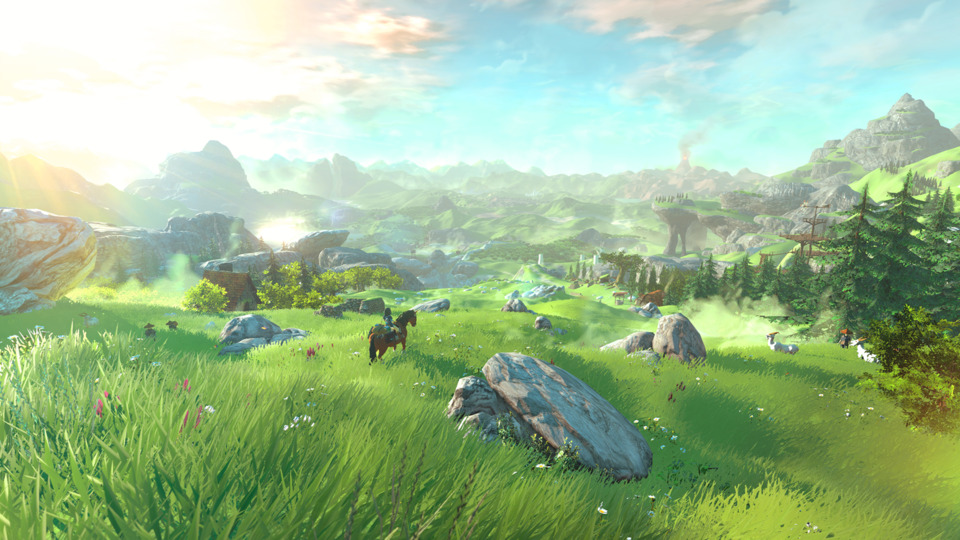
Every night, I sat on the couch and played until I genuinely couldn’t stay awake any longer. Every morning, I couldn’t get out of bed and turn on the Switch fast enough. Near the end, I found myself getting sad as I climbed the final towers and saw the map fill in. This Hyrule gave me such a profound sense of discovery, and I never wanted the mysteries to end. Even now, I have no idea of the purpose of numerous things that I saw. Ganon may be dead and I watched the credits roll, but I want to keep jumping back in until I’ve seen everything there is to see.
This sense of wonder is something that I haven’t felt so strongly since I played A Link to the Past when I was seven years old. Ocarina of Time was able to capture some of that same magic in my teenage years. Now that I’m in my thirties, I don’t think that I expected it to be possible for a game to make me feel like that again. I’ve been reviewing video games for twelve years now, and I’m used to describing games in a certain way. “This game controls well. This mechanic is innovative. The graphics are stunning. The skill tree feels limited.” That type of language doesn’t adequately convey how Breath of the Wild made me feel. Nintendo may have changed so many long-standing traditions of the Zelda franchise, but the spirit of discovery is as strong as it’s ever been no matter your age. I didn’t think I’d feel the Zelda magic this strongly ever again, but I couldn't be happier to be proven wrong.